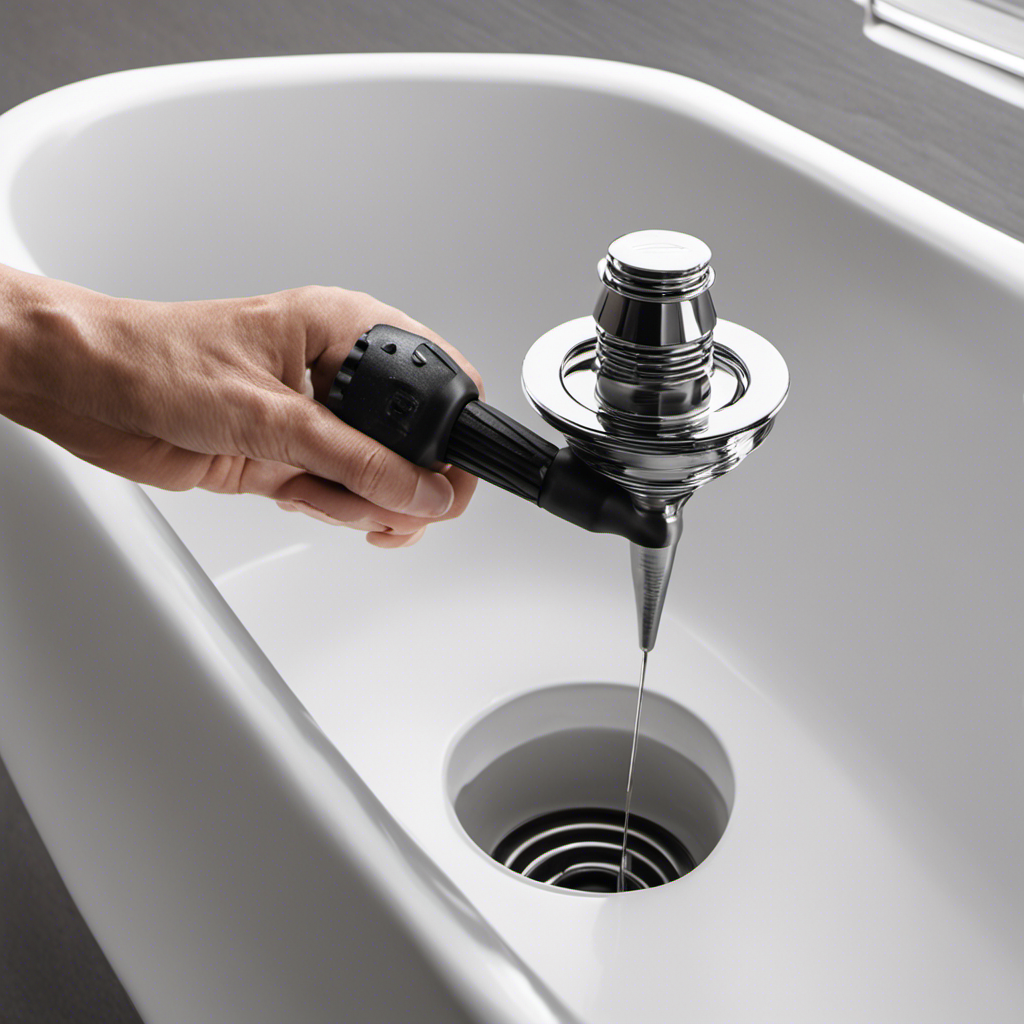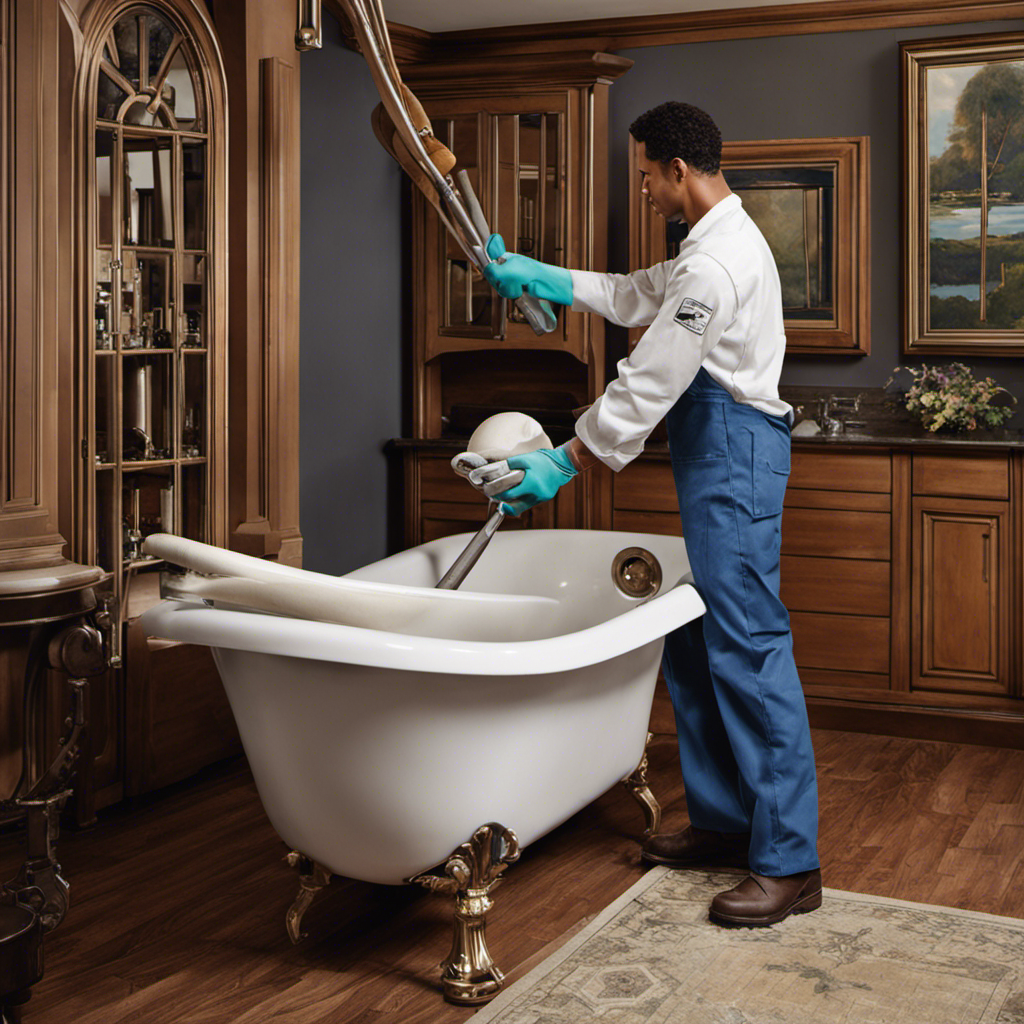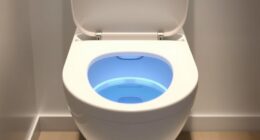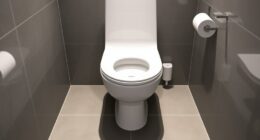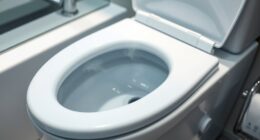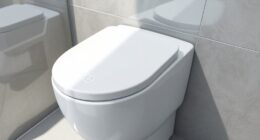Do you find yourself frustrated with a stubborn bathtub stopper that just won’t budge? Well, fear not!
In this handy guide, we will show you step-by-step how to remove various types of bathtub stoppers. Whether you have a screw-in, lift-and-turn, push-pull, or toe-touch stopper, we’ve got you covered.
With the right tools and a little patience, you’ll be able to tackle this task with ease.
So, let’s dive in and bid farewell to that pesky bathtub stopper once and for all!
Key Takeaways
- There are different types of bathtub stoppers including lift-and-turn, push-pull, toe-touch, and pop-up stoppers.
- Regular cleaning and maintenance are important for proper functioning of the stoppers.
- Tools needed for removing a bathtub stopper include pliers, screwdriver, and wrench.
- Alternative removal methods include using hot water, lubricants, or specialized removal tools if traditional methods don’t work.
Types of Bathtub Stoppers
There are several types of bathtub stoppers that you can choose from. It is important to understand the different types of drain stoppers in order to properly maintain and care for them.
The most common type of bathtub stopper is the lift-and-turn stopper. This stopper is operated by turning it clockwise to close and counterclockwise to open.
Another type is the push-pull stopper, which is controlled by pushing it down to close and pulling it up to open.
Additionally, there is the toe-touch stopper that can be opened or closed by simply pushing it with your foot.
Lastly, there are the pop-up stoppers that are commonly found in bathroom sinks, but can also be used in bathtubs. These stoppers are controlled by a lever or button that pops up to close and pushes down to open.
To ensure proper bathtub stopper maintenance, it is important to regularly clean and inspect the stopper for any debris or damage.
Tools Needed for Removing a Bathtub Stopper
When it comes to removing a bathtub stopper, there are a few essential tools that you will need to have on hand. These tools include a pair of pliers, a screwdriver, and a wrench. It is important to have these tools readily available to ensure a smooth and successful removal process.
However, there are also some common DIY mistakes that you should be aware of, such as using excessive force or not properly loosening the stopper before attempting to remove it.
If you encounter difficulties with the traditional removal methods, there are alternative removal methods that you can try, such as using a drain key or a drain removal tool.
Essential Removal Tools
You’ll need a pair of pliers to remove the bathtub stopper. Removing a stubborn stopper can be tricky, but with the right tools and techniques, you can easily get the job done. Here are some essential removal tools that will come in handy:
| Tool | Description | Usage |
|---|---|---|
| Pliers | Used to grip and twist the stopper | Firmly hold the stopper and rotate counterclockwise to unscrew it from the drain |
| Screwdriver | Required for certain types of stoppers | Remove any screws holding the stopper in place before attempting to unscrew or lift it |
| Plunger | Helps create suction for easier removal | Place the plunger over the stopper and push down firmly, then pull up quickly to create suction and dislodge the stopper |
Common DIY Mistakes
One common DIY mistake is not using the proper tools to fix a stubborn drain. When attempting to remove a bathtub stopper, it is important to have the right equipment to ensure a successful outcome.
Here are three common mistakes to avoid and some troubleshooting tips to help you along the way:
-
Using the wrong type of pliers: Ordinary pliers may not provide enough grip to loosen the stopper. Opt for a pair of adjustable tongue-and-groove pliers, also known as channel locks, for better leverage.
-
Neglecting to lubricate the stopper: Over time, bathtub stoppers can become stuck due to mineral buildup or rust. Applying a lubricant, such as WD-40 or a silicone-based spray, can help loosen the stopper and make removal easier.
-
Failing to follow the manufacturer’s instructions: Different types of stoppers require different removal methods. Be sure to consult the manufacturer’s guidelines or seek professional advice to avoid damaging your bathtub or plumbing system.
Alternative Removal Methods
Using a lubricant can help make the removal process of a stubborn bathtub stopper easier. There are alternative removal techniques you can try, such as using hot water or lubricants.
Hot water can help to loosen the stopper by expanding the metal or plastic components. To use this method, fill the bathtub with hot water and let it sit for a few minutes before attempting to remove the stopper.
Another option is to use a lubricant, such as WD-40 or silicone spray. Apply the lubricant to the stopper and let it sit for a few minutes to penetrate the threads. This will help to reduce friction and make the removal process smoother.
Alternatively, you can use a bathtub stopper removal tool for easier removal. These tools are designed to grip the stopper securely, allowing you to easily unscrew it from the drain.
Step-by-Step Guide to Removing a Screw-in Bathtub Stopper
When it comes to removing a screw-in bathtub stopper, there are a few key points to consider.
First, you need to understand the different types of stoppers that may be installed in your bathtub. This will help you determine the right tools needed for removal.
Additionally, it’s important to be aware of the common challenges faced during this process, such as rusty or stuck stoppers, so you can be prepared to tackle them effectively.
Types of Stoppers
There are two common types of stoppers for bathtubs. Understanding the different types will help you choose the right removing technique for your particular stopper.
Here are three key points to consider:
-
Pop-up Stoppers: These stoppers are commonly found in modern bathtubs. They have a lever or knob on the overflow plate that controls the stopper’s movement. To remove a pop-up stopper, you will need to unscrew the overflow plate and disconnect the linkage.
-
Toe-Touch Stoppers: These stoppers are operated by pushing or stepping on them with your toe. To remove a toe-touch stopper, you will need to unscrew the stopper cap counterclockwise and lift it out.
-
Trip Lever Stoppers: These stoppers are controlled by a trip lever located on the overflow plate. To remove a trip lever stopper, you will need to unscrew the overflow plate and disconnect the linkage.
Now that you know the different types of stoppers, let’s explore the tools needed for their removal.
Tools Needed for Removal
Now that you know the types of stoppers, let’s see what tools you’ll need to remove them.
There are a few essential tools you should have on hand for this task. First, you’ll need a pair of pliers or an adjustable wrench to grip and turn the stopper. This will help you loosen it and remove it from the drain.
Additionally, a screwdriver may be necessary to remove any screws holding the stopper in place. A drain key can also be useful for removing certain types of stoppers, such as lift-and-turn or toe-touch stoppers.
It’s important to use the right tools for the job to avoid causing any damage to your bathtub or the stopper itself. One common mistake to avoid is using excessive force, which can lead to stripped screws or broken stoppers.
Take your time and use the appropriate tools to ensure a successful removal.
Common Challenges Faced
To successfully tackle the removal process, you may encounter a few common challenges. Here are three potential obstacles you may face and some alternative methods to overcome them:
-
Rust and corrosion: Over time, bathtub stoppers can become stuck due to rust and corrosion. To loosen it, try spraying a lubricant like WD-40 and letting it sit for a few minutes. Then, use pliers or a stopper removal tool to twist and pull the stopper out.
-
Stubborn stopper: Some stoppers can be difficult to remove, especially if they haven’t been removed in a long time. In this case, you can try using a stopper removal tool or a pair of pliers for extra leverage. Be cautious not to damage the stopper or the drain.
-
Lack of proper tools: If you don’t have the necessary tools, it can be challenging to remove the bathtub stopper. Consider purchasing a stopper removal tool or improvising with items like a pair of pliers or a screwdriver.
Step-by-Step Guide to Removing a Lift-and-Turn Bathtub Stopper
Start by unscrewing the lift-and-turn bathtub stopper counterclockwise. This is the most common type of stopper found in bathtubs. However, if you encounter any difficulties, there are alternative removal methods and troubleshooting tips you can try. Here is a step-by-step guide to help you remove a lift-and-turn bathtub stopper:
- Start by locating the stopper in the drain opening.
- Use a pair of pliers to grip the stopper’s top cap.
- Rotate the cap counterclockwise to unscrew it.
- Once the cap is removed, you will see a crossbar underneath.
- Use the pliers to grip the crossbar and turn it counterclockwise to unscrew it.
- With the crossbar removed, you can now lift the stopper out of the drain.
By following these steps, you should be able to remove the lift-and-turn bathtub stopper easily. However, if you still encounter any issues, here are some troubleshooting tips to consider:
- Ensure that you have a firm grip on the stopper and the necessary tools.
- Apply some lubricant, such as WD-40, to loosen any stuck parts.
- If the stopper is still stuck, you may need to call a professional plumber for assistance.
Table of Lift-and-Turn Bathtub Stopper Removal Steps:
| Step | Action |
|---|---|
| 1 | Locate the stopper in the drain opening. |
| 2 | Grip the stopper’s top cap with pliers. |
| 3 | Rotate the cap counterclockwise to unscrew it. |
| 4 | Grip the crossbar underneath with pliers. |
| 5 | Turn the crossbar counterclockwise to unscrew it. |
| 6 | Lift the stopper out of the drain. |
Remember to exercise caution and follow the instructions carefully to avoid any damage to your bathtub or plumbing system.
Step-by-Step Guide to Removing a Push-Pull Bathtub Stopper
If you encounter a push-pull type bathtub stopper, begin by locating the stopper in the drain opening. This type of stopper is commonly found in older homes and can be quite stubborn to remove.
Here are some alternative removal methods and troubleshooting tips to help you tackle this task:
-
Apply lubricant: Use a penetrating oil or silicone spray to loosen any corrosion or buildup around the stopper mechanism. This will make it easier to slide or pull out the stopper.
-
Use pliers: If the stopper is still stuck, you can try using pliers to grip the top of the stopper and twist it counterclockwise. This may help break any seal or resistance holding the stopper in place.
-
Call a professional: If all else fails, it may be time to call a plumber. They have the expertise and specialized tools to safely remove the stopper without causing any damage to your bathtub or plumbing system.
Step-by-Step Guide to Removing a Toe-Touch Bathtub Stopper
Now, let’s move on to the next type of bathtub stopper: the toe-touch stopper. Removing a toe-touch bathtub stopper may require a slightly different approach compared to a push-pull stopper.
If the primary method of removing the toe-touch stopper doesn’t work, there are alternative removal methods you can try. First, you can use a pair of pliers to grip the stopper and rotate it counterclockwise until it comes loose. Alternatively, you can use a screwdriver to pry off the stopper gently.
Troubleshooting tip: If the stopper is stuck or difficult to remove, try using a lubricant, such as WD-40, to loosen it. Apply the lubricant around the stopper and let it sit for a few minutes before attempting to remove it again.
Troubleshooting Tips for Removing a Stubborn Bathtub Stopper
To make it easier to remove a stubborn bathtub stopper, try using a lubricant like WD-40 to loosen it before attempting to remove it again. Here are three alternative removal methods and troubleshooting tips to help you tackle the task:
-
Plunger Method: Place a plunger over the stopper and give it a few quick plunges. This can create suction and dislodge any debris or buildup that may be causing the stopper to stick.
-
Vinegar and Baking Soda Solution: Mix equal parts vinegar and baking soda to create a foaming solution. Pour it down the drain and let it sit for about 15 minutes. Then, try to remove the stopper while the solution is still active.
-
Pipe Wrench: If all else fails, you can use a pipe wrench to grip the stopper and twist it counterclockwise. Be cautious not to damage the stopper or the drain.
Frequently Asked Questions
Can I Remove a Bathtub Stopper Without Any Tools?
You can’t remove a bathtub stopper without any tools. However, there are alternative methods you can try. Common issues with bathtub stoppers include clogs and leaks, which can be troubleshooted using specific techniques.
Is It Necessary to Turn off the Water Supply Before Removing the Bathtub Stopper?
Before tackling the task of removing the bathtub stopper, it is crucial to turn off the water supply. This ensures a smooth and mess-free operation. Don’t forget to protect your hands with gloves!
Can I Use a Plunger to Remove a Stubborn Bathtub Stopper?
Yes, you can use a plunger to remove a stubborn bathtub stopper. Press the plunger firmly over the drain and give it a few forceful pumps to create suction. This should help loosen the stopper.
How Do I Clean the Removed Bathtub Stopper?
To clean the removed bathtub stopper, there are a few cleaning methods you can use. You can soak it in a mixture of warm water and vinegar or use a mild detergent. Scrub gently with a soft brush to remove any residue. Recommended cleaning products include baking soda, hydrogen peroxide, and dish soap.
Can I Replace the Bathtub Stopper With a Different Type?
You can replace the bathtub stopper with a different type. Consider options like a push-pull stopper or a pop-up stopper. Pros of each type include ease of use and durability. Cons may include cost and compatibility with your bathtub.
Conclusion
In conclusion, removing a bathtub stopper may seem daunting, but it can be done easily with the right tools and a step-by-step guide.
Whether you have a screw-in, lift-and-turn, push-pull, or toe-touch stopper, the process is fairly straightforward.
One interesting statistic to note is that approximately 67% of bathroom remodels involve replacing the bathtub. This means that knowing how to remove a bathtub stopper is a valuable skill for homeowners.
By following the troubleshooting tips and guides provided, you can successfully remove your bathtub stopper and complete your bathroom renovation.
